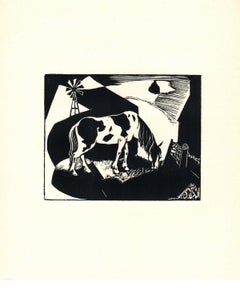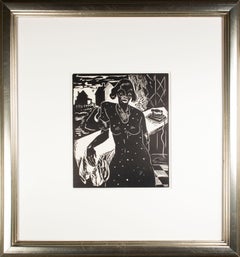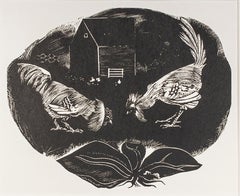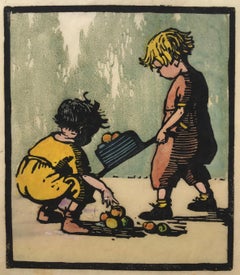Howard Thomas Art
1
to
4
1
1
2
2
4
Overall Height
to
Overall Width
to
4
3
2
1
1
1
1
1
1
4
4
4
6,934
3,279
2,514
1,213
3
1
1
Artist: Howard Thomas
1939 Howard Thomas 'Indian Pony'
By Howard Thomas
Located in Brooklyn, NY
Paper Size: 9.25 x 9 inches ( 23.495 x 22.86 cm )
Image Size: 4 x 5 inches ( 10.16 x 12.7 cm )
Framed: No
Condition: A: Mint
Additional Details: This piece derives from the 193...
Category
1930s American Modern Howard Thomas Art
Materials
Woodcut
'Monday in Wick Haven' original linoleum cut print by Howard Thomas
By Howard Thomas
Located in Milwaukee, WI
In this image, Howard Thomas presents the viewer with a domestic interior. The image is dominated by the figure of a black woman, resting her arm on an ironing board. To the right, the tool of her task dangles a chord above a checker tiled floor. Beyond, though a window, neighboring homes fill the landscape. The careful line-work of the linocut adds a sense of expressionism to the scene, but the image nonetheless falls into the Social Realism that captivated most American artists during the Great Depression.
This print was published in 1936 as part of the Wisconsin Artists' Calendar for the year 1937, which included 52 original, hand-made prints – one for each week of the year.
6 x 5 inches, image
10 x 7.13 inches, sheet
12.37 x 12.43 inches, frame
Entitled "Monday in Wick Haven" lower left (covered by matting)
Inscribed "Linoleum Cut" lower center (covered by matting)
Artist name "Howard Thomas" lower right (covered by matting)
Framed to conservation standards using 100 percent rag matting and museum glass, all housed in a silver gilded moulding.
Quaker-born in Ohio, Thomas trained in the Midwest at Ohio State University and the Chicago Art Institute. He taught in the Art Department of the Milwaukee State Teachers College (now University of Wisconsin-Milwaukee) where he became good friends with Carl Holty, Edward Boerner, Robert von Neumann...
Category
1930s American Modern Howard Thomas Art
Materials
Linocut, Engraving
"White Horse, " Wood Engraving signed in Image by Howard Thomas
By Howard Thomas
Located in Milwaukee, WI
"White Horse" is an original wood engraving by Howard Thomas, signed in the lower right hand corner. A white horse trots past the foreground of the image, spirals in it's eyes and sp...
Category
1930s American Modern Howard Thomas Art
Materials
Woodcut
"Brahma vs. Leghorn, " Farm Scene Wood Engraving by Howard Thomas
By Howard Thomas
Located in Milwaukee, WI
"Brahma vs. Leghorn" is an original wood engraving by Howard Thomas. In front of an understated farm house, Brahma and Leghorn face off, ready to battle. An unidentified plant sits on the center.
Image: 6" x 7.44"
Framed: 13.75" x 15.18
Thomas Howard (1899-1971) born a Quaker in Ohio, trained in the Midwest at Ohio State University and the Chicago Art Institute. He taught in the Art Department of the Milwaukee State Teachers College (now University of Wisconsin-Milwaukee) where he became good friends with Carl Holty, Edward Boerner, Robert von Neumann...
Category
1930s American Modern Howard Thomas Art
Materials
Woodcut
Related Items
FRUIT FOR SALE
By Frances H. Gearhart
Located in Santa Monica, CA
FRANCES H. GEARHART and Sisters (THE GEARHARTS)
FRUIT FOR SALE c.1928
Color block print. Unsigned. This is an original block print from “Let’s Play”, an intended but unpublished children’s book done in collaboration with her sisters Edna and May in 1928. Image 8 x 7 inches. On a tissue thin laid paper. Irregular sheet 9 3/8 x 8 1/2. The entire series consisted of over 20 children's images.
There were very few printed. The editions of the various children varied but likely no more than 50. This impression very well printed with good colors, Very good condition. The margins are likely as issued with the irregular edges. The margins and paper used for this series varies from one print to the next. A bit of tape remnants at top center sheet edge. A very nice example of this print.
It is not unusual for impressions of this series to be unsigned, although many are signed "The Gearharts"
The Provenance of this example is fascinating. It was acquired from a gentleman who knew the Gearharts as a child in the early 50's in Pasadena. It was part of a collection given to him by Frances. In his adult years he was in the military and took the collection with him as he traveled around Europe,
After 81 years, based on the original prints, this book was published by
the “California Book...
Category
1920s American Modern Howard Thomas Art
Materials
Woodcut, Linocut
Dusk
By Louisa Chase
Located in New York, NY
Louisa Chase was born in Panama City, Panama. Seven years later, her family moved to Lancaster, Pennsylvania. She studied painting and sculpture at Syracuse University and at the Yal...
Category
Late 20th Century American Modern Howard Thomas Art
Materials
Woodcut
'The Start of the Race' — America's Cup, 1899
By Jacques La Grange
Located in Myrtle Beach, SC
Jacques La Grange, 'The Start of the Race, 1899', color woodcut, edition 500, 1934. Signed and numbered '21/500' in pencil. A fine impression, with fresh colors, on cream wove paper,...
Category
1930s American Modern Howard Thomas Art
Materials
Woodcut
Saturday Morning (Market, Taos Plaza, New Mexico), 1950s Figural Linocut Print
By Barbara Latham
Located in Denver, CO
1950s modernist linoleum cut print titled 'Saturday Morning (Market, Taos Plaza, New Mexico) by New Mexican artist Barbara Latham. Depicting a busy Saturday morning at the market in Taos Pueblo with horse and cart, Native American figures, adobe buildings and mountains in the background. Presented in a custom frame with all archival materials, outer dimensions measure 16 x 17 ¾ inches. Image size is 8 ½ x 10 ½ inches.
About the Artist:
Beginning her career as a commercial artist, Barbara Latham travelled to Taos in 1925 seeking material for a greeting card. Serendipitously, she also found her life partner, Howard Cook, who was similarly looking for ideas for illustrations. Perhaps both were fueled in their quest by the tales of their mutual teacher, Andrew Dasburg, who knew of the energy and stimulation of this artist community. Observing local people and customs, Latham created genre scenes that offer a window into this now-vanished time and place. Her lively illustrations for numerous children's books are a significant contribution to that graphic art in the mid-20th century.
Born in Walpole, Massachusetts, Latham's student days included Norwich Art School and Pratt Institute in Brooklyn; but it was contact with the charismatic Dasburg at the Art Students League in Woodstock that opened her world and her view of art. Getting work with companies like Norcross Publishing and Forum magazine, she eventually made her way to Taos. Among all the spirited young artists gathered there, she met Howard Cook, who was designing illustrations for Willa Cather's Death Comes to the Archbishop. The two married in Santa Fe and began a nomadic life together.
The young couple made their way to Paris, a likely destination for modernist artists. Upon receiving a Guggenheim to study fresco painting in 1932, Cook, along with Latham, took an alternative direction and headed to Taxco, Mexico. At this time, Mexican muralists, such as Diego Rivera, were capturing the attention of progressive artists. During the Depression, both Cook and Latham aligned themselves with a populist ideal. Latham contributed work, such as "Fording the Stream" and "Bear Family," to the American Artists Group, which was founded to produce original prints at affordable prices. The couple also travelled in the Deep South to the Ozarks and to "Alabama's Black Belt."
When Latham settled in Taos, she was committed to an art of and for the people. Rather than a romanticized re-creation, her choice of subjects was based in common everyday activities, favoring those which brought people together. Taos Pueblo was an ancient, indigenous community, and Latham's view extended that tradition into a contemporary, multi-ethnic village. Sharing some of the spirit of WPA photographs...
Category
Mid-20th Century American Modern Howard Thomas Art
Materials
Linocut
The Gargoyle and His Quarry
By John Taylor Arms
Located in Storrs, CT
The Gargoyle and His Quarry, Notre Dame. 1920. Etching.Fletcher 90. 7 1/8 x 5 1/4 (sheet 10 1/2 x 9 1/16). Gargoyle series #1. Edition 75. A rich impression printed on 'FJHead&Co' c...
Category
1920s American Modern Howard Thomas Art
Materials
Drypoint, Etching
Original New Orleans Jazz & Heritage Festival vintage poster
Located in Spokane, WA
Original New Orleans Jazz & Heritage Festival original 1983 vintage poster. Archival linen backed in very good condition, ready to frame. ...
Category
1980s American Modern Howard Thomas Art
Materials
Offset
House on Cliff Walk, Newport, Rhode Island
By Clifford Isaac Addams
Located in Storrs, CT
House on Cliff Walk, Newport, R.I. 1931-1932. Etching and drypoint. Hausberg catalog 13 state .i/ii. Edition 75 in this state. 5 7/8 x 7 7/8 (sheet 9 x 13 1/2). A rich impression pr...
Category
Mid-20th Century American Modern Howard Thomas Art
Materials
Drypoint, Etching
Alexander Calder Circus Reproduction Lithograph After a Drawing
By (after) Alexander Calder
Located in Surfside, FL
(after) Alexander Calder
"Calder's Circus" offset lithograph on wove paper after drawings by the artist
Published by Art in America and Perls gallery in 1964 (from drawings done in the 1930's)
these range slightly in size but they are all about 13 X 17 inches (with minor variations in size as issued.) These have never been framed. The outer folio is not included just the one lithograph.
James Sweeny from the introduction “The fame of Calder’s circus spread quickly between the years 1927 and 1930. All the Paris art world came to know it. It brought him his first great personal success. But what was more important, the circus also provided the first steps in Calder’s development as an original sculptor”
Clive Gray...
Category
1930s American Modern Howard Thomas Art
Materials
Lithograph
Underwater — Mid-century Modern
By Charles Quest
Located in Myrtle Beach, SC
Charles Quest, 'Underwater', 1948, chiaroscuro wood engraving, edition 12. Signed, titled, dated and numbered '3/12' in pencil. A fine, richly-inked impression, in dark brown and warm black, on off-white wove paper, with full margins (5/8 to 1 1/2 inch), in excellent condition. Scarce.
ABOUT THE ARTIST
Charles Quest, painter, printmaker, and fine art instructor, worked in various mediums, including mosaic, stained glass, mural painting, and sculpture. Quest grew up in St. Louis, his talent evident as a teenager when he began copying the works of masters such as Michelangelo on his bedroom walls. He studied at the Washington University School of Fine Arts, where he later taught from 1944 to 1971. He traveled to Europe after his graduation in 1929 and studied at La Grande Chaumière and Academie Colarossi, Paris, continuing to draw inspiration from the works of the Old Masters.
After returning to St. Louis, Quest received several commissions to paint murals in public buildings, schools, and churches, including one from Joseph Cardinal Ritter, to paint a replica of Velasquez's Crucifixion over the main altar of the Old Cathedral in St. Louis. Quest soon became interested in the woodcut medium, which he learned through his study of J. J. Lankes' A Woodcut Manual (1932) and Paul Landacre's articles in American Artist magazine ‘since no artists in St. Louis were working in wood’ at that time. Quest also revealed that for him, wood cutting and engraving were ‘more enjoyable than any other means of expression.’
In the late 1940s, his graphic works began attracting critical attention—several of his woodcuts won prizes and were acquired by major American and European museums. His wood engraving entitled ‘Lovers’ was included in the American Federation of Art's traveling print exhibition in 1947. Two years later, Quest's two prize-winning prints, ‘Still Life with Grindstone’ and ‘Break Forth into Singing’, were exhibited in major American museums in a traveling show organized by the Philadelphia Print Club. His work was included in the Chicago Art Institute's exhibition, ‘Woodcut Through Six Centuries’, and the print ‘Still Life with Vise’ was purchased by the Museum of Modern Art in New York.
In 1951 he was invited by artist-Curator Jacob Kainen to exhibit thirty wood engravings and color woodcuts in a one-person show at the Smithsonian's National Museum (now known as the American History Museum). Kainen's press release praised the ‘technical refinement’ of Quest's work: ‘He obtains a great variety of textural effects through the use of the graver, and these dense or transparent grays are set off against whites or blacks to achieve sparkling results. His work has the handsome qualities characteristic of the craftsman and designer.’
At the time of the Smithsonian exhibition, Quest's work was represented by three New York galleries in addition to one in his home town. He had won 38 prizes, and his prints were in the collections of the Library of Congress, the Chicago Art Institute, the Metropolitan Museum, and the Philadelphia Museum of Art. In cooperation with the Art in Embassies program, his color woodcuts were displayed at the American Embassy in Paris in 1951.
Recognition at home came in 1955 with his first solo exhibition in St. Louis. Press coverage of the show heralded the ‘growth of graphic arts toward rivaling painting and sculpture as a major independent medium’.
An exhibition of his prints at the Bethesda Art Gallery in 1983 attracted Curator Emeritus Joseph A. Haller, S.J., who began purchasing his work for Georgetown University's collection. In 1990 Georgetown University Library's Special Collections Division was the recipient of a large body of Quest's work, including prints, drawings, paintings, sculpture, stained glass, and his archive of correspondence and professional memorabilia. These extensive holdings, including some 260 of his fine prints, provide a rich opportunity for further study and appreciation of this versatile and not-to-be-forgotten mid-Western American artist...
Category
1940s American Modern Howard Thomas Art
Materials
Woodcut
Fountain of Sea Horses, Rome — Early 20th Century
By Rudolph Ruzicka
Located in Myrtle Beach, SC
Rudolph Ruzicka, 'Fountain of Sea Horses, Rome', wood engraving, c. 1915. Signed, dated, and titled in pencil. Initialed in the block, lower left. A fine, richly-inked impression, on...
Category
1910s American Modern Howard Thomas Art
Materials
Woodcut
Bailey's Beach, Newport, Rhode Island.
By Clifford Isaac Addams
Located in Storrs, CT
Bailey's Beach (Newport, Rhode Island). 1933. Etching. Hausberg 126 state v/vi. Edition 75. 6 x 7 7/8 (sheet 9 3/8 x 12 3/8). Printed with extensive plate tone with plate tone on 'Va...
Category
Mid-20th Century American Modern Howard Thomas Art
Materials
Drypoint, Etching
The Gothic Spirit
By John Taylor Arms
Located in Storrs, CT
The Gothic Spirit (also called A Gargoyle, A Gothic Spirit). 1922. Etching and stipple. Fletcher 120. 11 5/8 x 7 (sheet 15 1/4 x 11 1/4). Gargoyle Series #8. Edition 130. Illustrated...
Category
1920s American Modern Howard Thomas Art
Materials
Drypoint, Etching
Howard Thomas art for sale on 1stDibs.
Find a wide variety of authentic Howard Thomas art available for sale on 1stDibs. You can also browse by medium to find art by Howard Thomas in woodcut print, engraving, linocut and more. Much of the original work by this artist or collective was created during the 1930s and is mostly associated with the modern style. Not every interior allows for large Howard Thomas art, so small editions measuring 9 inches across are available. Customers who are interested in this artist might also find the work of Frank Kleinholz, Charles Turzak, and Cecil Crosley Bell. Howard Thomas art prices can differ depending upon medium, time period and other attributes. On 1stDibs, the price for these items starts at $300 and tops out at $1,300, while the average work can sell for $1,284.





